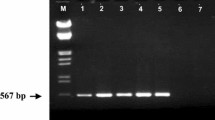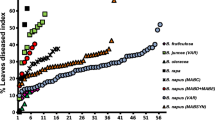Summary
Seven soft red winter wheat cultivars were evaluated for partial resistance to Leptosphaeria nodorum under field conditions. The results demonstrate that resistance is available among cultivars that are adapted to the southeastern U.S. and that resistance is long lasting. Resistant cultivars had longer incubation and latent periods, slower rates of lesion development, and reduced the level of sporulation of L. nodorum. Seedlings of susceptible cultivars sustained severe disease with dew periods as short as 48 hr in greenhouse tests. One resistant cultivar sustained little damage with dew period as long as 144 hr.
Latent period was shortest on the second leaf below the flag leaf (F-2 leaf) of all cultivars and longest on the flag leaf which reflected the effect of microclimate and leaf age. The range in length of latent period on the flag, F-1, and F-2 leaves of resistant cultivars was less than that for susceptible cultivars. Differences between cultivars were greatest (up to 6.8 days) for the F-2 leaf. A delay in production of inoculum on the F-2 and lower leaves of resistant cultivars should delay infection of the flag leaf and spike.
The greatest differentiation among cultivars for sporulation of L. nodorum was on upper leaves at Feekes growth stage 11.2. ‘Oasis’ consistently had less sporulation than other cultivars at all sampling dates and leaf positions. The rate of disease progress up the plant (disease severity) and area under the disease progress curve were also least on ‘Oasis’.
There were significant correlations among components of resistance and associated components suggesting that a single or interrelated mechanisms control expression of resistance. Overall, ‘Oasis’ was the most resistant cultivar followed by ‘Coker 762’ and ‘Coker 747’. There cultivars have remained resistant for ten or more years. ‘Stacy’ was intermediate in resistance and was the most variable of the seven cultivars for the components tested. ‘Holley’, ‘Omega 78’, and ‘Florida 301’ were highly susceptible by all criteria tested. Plant height was not a factor in resistance. The resistant cultivars are mostly later in maturity than the susceptible cultivars. In this study, crop maturity was similar under existing environmental conditions during the two seasons when most data were collected.
Similar content being viewed by others
References
Brennan, R.M., B.D.L.Fitt, G.S.Taylor & J.Colhoun, 1985. Dispersal of Septoria nodorum pycnidiospores by simulated raindrops in still air. Phytopath Z 112: 281–290.
Cunfer, B.M., 1984. Change of virulence of Septoria nodorum during passage through barley and wheat. Ann Appl Biol 104: 61–68.
Eyal, Z., J.F.Brown, J.M.Krupinsky & A.L.Scharen, 1977. The effect of postinoculation periods of leaf wetness on the response of wheat cultivars to infection by Septoria nodorum. Phytopathology 67: 874–878.
Fried, P., D.R.MacKenzie & R.R.Nelson, 1979. Dispersal gradients from a point source of Erysiphe graminis f. sp. tritici, on Chancellor winter wheat and four multilines. Phytopath Z 95: 140–159.
Griffiths, H., 1985. A bioassay for predicting the resistance of wheat leaves to Septoria nodorum. In: Scharen A.L. (ed.). Septoria of Cereals: Proceedings of the Workshop. USDA-ARS-12. pp 83–84.
James, W.C., 1971. An illustrated series of assessment keys for plant diseases, their preparation and usage. Can Pl Dis Surv 51: 39–65.
Jeger, M.J., D.G.Jones & E.Griffiths, 1983. Components of partial resistance of wheat seedlings to Septoria nodorum. Euphytica 32: 575–584.
Johnson, R., 1981. Durable disease resistance. In: Jenkyn J.F. & Plumb R.T. (eds.). Strategies for the Control of Cereal Disease. pp 55–63.
Large, E.C., 1954. Growth stages in cereals-illustration of the Feekes scale. Plant Pathol 3: 128–129.
Leonard, K.J. & C.C.Mundt, 1984. Methods for estimating epidemiological effects of quantitative resistance to plant diseases. Theor Appl Genet 67: 219–230.
Mullaney, E.J., J.M.Martin & A.L.Scharen, 1982. Generation mean analysis to identify and partition the components of genetic resistance to Septoria nodorum in wheat. Euphytica 31: 539–545.
Nass, H.G. & H.W.Johnston, 1985. Evaluation of methods and criteria for identifying resistance to Septoria nodorum in spring wheat. Can J Pl Path 7: 91–97.
Nelson, L.R. & C.E.Gates, 1982. Genetics of host resistance of wheat to Septoria nodorum. Crop Sci 22: 77–73.
Osman-Ghani, N. & J.G.Manners, 1985. Components of partial resistance to Puccinia striiformis in barley. Plant Pathol 34: 75–82.
Parlevliet, J.E., 1979. Components of resistance that reduce the rate of epidemic development. Ann Rev Phytopathol 17: 203–222.
Parlevliet, J.E., M.Leijn & A.VanOmmeren, 1985. Accumulating polygenes for partial resistance in barley to barley leaf rust, Puccinia hordei. II. Field evaluation. Euphytica 34: 15–20.
Rapilly, F., P.Auriau, Y.Laborie & C.Depatureau, 1984. Recherches sur la resistance partielle du ble tendre a Septoria nodorum Berk. Agronomie 4: 639–651.
Rosielle, A.A. & A.G.P.Brown, 1980. Selection for resistance to Septoria nodorum in wheat. Euphytica 29: 337–346.
Scott, P.R., P.W.Benedikz & C.J.Cox, 1982. A genetic study of the relationship between height, time of ear emergence and resistance to Septoria nodorum in wheat. Plant Pathol 31: 45–60.
Scott, P.R., P.W.Benedikz & H.G.Jones, 1985. Some effects of canopy structure and microclimate on infection of tall and short wheats by Septoria nodorum. Plant Pathol 34: 578–593.
Shaner, G. & R.E.Finney, 1977. The effect of nitrogen fertilization on the expression of slow-mildewing resistance in Knox wheat. Phytopathology 67: 1051–1056.
Shaner, G. & F.D.Hess, 1978. Equations for integrating components of slow leaf-rusting resistance in wheat. Phytopathology 68: 1464–1469.
Shearer, B.L. & J.C.Zadoks, 1972. The latent period of Septoria nodorum in wheat. I. The effect of temperature and moisture treatments under controlled conditions. Neth J Pl Path 78: 231–241.
Stooksbury, D.E., 1985. Inheritance and components of resistance of seven soft red winter wheat (Triticum aestivum L.) cultivars to Leptosphaeria nodorum E. Müller. M.S. thesis. University of Georgia. 60 pp.
Van derPlank, J.E., 1963. Plant diseases: Epidemics and control. Academic Press, New York, 349 pp.
Author information
Authors and Affiliations
Rights and permissions
About this article
Cite this article
Cunfer, B.M., Stooksbury, D.E. & Johnson, J.W. Components of partial resistance to Leptosphaeria nodorum among seven soft red winter wheats. Euphytica 37, 129–140 (1988). https://doi.org/10.1007/BF00036850
Received:
Accepted:
Issue Date:
DOI: https://doi.org/10.1007/BF00036850




